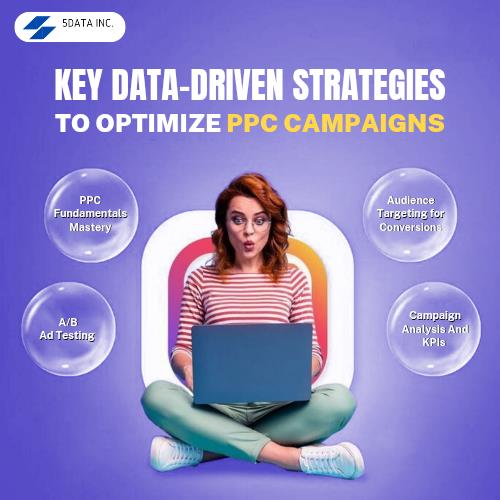Amidst the stiff competition in running digital ads today, businesses need to follow a data-centric approach to PPC advertising if they want to achieve the most profitable ROI. Keyed-in keyword targeting, proper bid control, and sophisticated audience profiling enable brands to attract quality traffic, which actually converts and improves overall ad performance. This article aims to identify critical components of ROI achievement and explain the power of analytics in propelling paid advertising strategies.
We assist companies with effective data management services ensuring proper storage, processing, and analysis of campaign data to drive long-term advertising value.
Key Takeaways
- Data-driven PPC strategies are more effective, as they enhance keyword targeting, expand audience reach, and increase cost efficiency.
- Marketing automation and AI tools are transforming paid advertising by allowing for real-time campaign optimization and smarter budget allocation.
- Continuous A/B testing and landing page optimization are essential for driving higher conversion rates and improving return on investment (ROI).
Key Data-Driven Strategies to Optimize PPC Campaigns
Old-fashioned PPC campaigns depend on instinct and job strategies. Nonetheless, with the appropriate approach, businesses can fine-tune every part of their Google Ads, including ad optimization and cost-per-click management. Decisions made based on data automate the campaign analytics, enabling better-targeted ads and improved click-through rates.
1. PPC Fundamentals Mastery
Comprehensive keyword targeting is the foundation of efficient PPC campaigns. High-intent keywords coupled with competitive, and user behavioral criteria will guarantee that your ad spend efficiency is maximized. Businesses also need to focus on negative keywords to reduce irrelevant traffic and substandard ad spending.
Cost control without compromising ad performance is critical, which is why bid management plays an important role. Automated bidding strategies within Google Ads can take the heat off optimizing budgets in real time by ensuring your ads appear in front of the right people at the right time.
2. Audience Targeting for Conversions
Optimizing ROI starts with understanding your audience. Through audience segmentation, advertisers can formulate personalized ads for specific user groups. Creating segments based on demographics, interests, and behavior enhances targeting, which results in high CTR and improved conversion rates.
Businesses can also use retargeting ads to re-engage visitors who previously interacted with their website. Retargeting helps nurture visitors and guide them down the conversion funnel.
3. A/B Ad Testing
Ad optimization is one of the most important aspects, and continuous improvement is critical. A/B testing is a great way to optimize images, headlines, descriptions, and calls to action to find the perfect combination that your audience best relates to. Also, enhancing landing page variation improves ad performance by ensuring users have a great experience after clicking an ad.
4. Campaign Analysis and KPIs
Effective decision-making requires a close watch over the performance metrics that matter most. CPC, CTR, and conversion rates are good examples of essential metrics that grant insight into ad performance. Campaign analytic tools like Google Analytics and others help advertisers analyze campaign results comprehensively.

How Marketing Automation Provides Security in PPC Campaigns
In modern marketing, automation is changing the digital advertisement space by effectively performing mundane tasks. Marketing automation tools help in bid management, scheduling, and campaign optimization in real-time. Automation secures a more data-oriented budget allocation, minimizing human errors and improving ROI overall.
For businesses with big datasets, Data Collection And Data Management Service Providers allow clean, structured, and useful data to be available for PPC method strategies.
Improving Ad Performance through Landing Page Optimization
The landing page is a virtual touchpoint through which interaction takes place and, therefore, constitutes an important component in the success of PPC campaigns. Optimizing landing pages with the right level of simplicity, speed, and user engagement maximizes the chance of conversion, not just from ad clicks but to actual leads or sales. Landing pages that achieve results must have good headlines, persuasive content, and well-organized structures to encourage users to interact with the content more.
Leveraging Retargeting Ads for Continued Engagement
Retargeting ads are highly effective for converting potential customers who did not complete a purchase or sign up initially. By focusing on people who’ve already clicked their ads or visited their website, businesses can re-engage leads and increase ad spend efficiency.
Once you’ve hooked someone with retargeting ads, the real magic happens in keeping them interested. By focusing on people who’ve already clicked your ads or visited your site, you’re not just chasing cold leads—you’re nurturing ones that are already warm. This approach cuts waste and lifts results, making your budget stretch further.
Smart technology is becoming more and more essential in this process, helping track what works and what doesn’t. Pair that with the Best Application Development Services, and you’ve got tools to manage it all seamlessly. It’s about building momentum—turning a single click into a loyal customer with every ad they see.
The Future of PPC Campaigns: AI and Data-Driven Insights
Smart technology like AI is becoming increasingly essential and is playing an increasingly important role in digital advertising. From predictive analytics to automated bid management, AI-powered tools are enhancing how advertisers optimize their campaigns. AI-driven insights help businesses make faster, data-backed decisions, ensuring that ad budgets are spent efficiently.
Companies investing in Best Application Development Services are also integrating AI-driven marketing solutions into their platforms. These solutions, such as predictive analytics and automated bid management, enable seamless PPC campaign management and advanced analytics capabilities, ensuring that ad budgets are spent efficiently.
Conclusion
Data-driven PPC campaigns offer unparalleled opportunities for ROI optimization. By leveraging keyword targeting, bid management, ad optimization, and marketing automation, businesses can maximize their ad performance and ad spend efficiency. The key to success lies in continuous A/B testing, detailed campaign analytics, and precise audience segmentation. With the right approach, paid search can become a powerful driver of business growth.
FAQs
Q: What numbers should you look at to figure out if your PPC campaign is doing well?
Key performance metrics include cost per click (CPC), click-through rate (CTR), conversion rates, and overall ad performance. Monitoring these metrics helps advertisers optimize their campaigns effectively.
Q: How can businesses improve ad spending efficiency in PPC campaigns?
By leveraging bid management, keyword targeting, and marketing automation, businesses can allocate budgets strategically to maximize ad spend efficiency and improve ROI optimization.
Q: How does comparing two ad versions help improve PPC advertising?
A/B testing allows advertisers to compare different ad variations to determine which elements perform best. This ensures continuous ad optimization and improved conversion rates.
Q: How does audience segmentation impact PPC campaigns?
Audience segmentation helps advertisers target specific groups based on demographics, interests, and behaviors. This leads to more personalized ads, higher click-through rates, and better engagement.
Q: What do retargeting ads do, and why do they matter so much?
Retargeting ads help businesses re-engage users who previously interacted with their site or ads. This strategy increases conversions by keeping the brand top-of-mind for potential customers.

Rasmita Patro
Author
